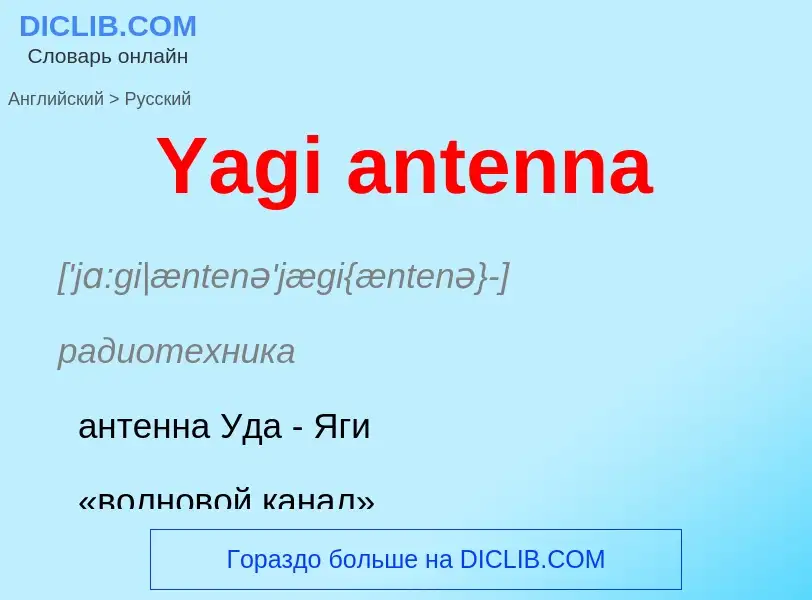Tradução e análise de palavras por inteligência artificial ChatGPT
Nesta página você pode obter uma análise detalhada de uma palavra ou frase, produzida usando a melhor tecnologia de inteligência artificial até o momento:
- como a palavra é usada
- frequência de uso
- é usado com mais frequência na fala oral ou escrita
- opções de tradução de palavras
- exemplos de uso (várias frases com tradução)
- etimologia
Yagi antenna - tradução para russo
['jɑ:gi|æntenə'jægi{æntenə}-]
радиотехника
антенна Уда - Яги
«волновой канал»
антенна типа "волновой канал"
общая лексика
антенна
Definição
Wikipédia

A Yagi–Uda antenna, or simply Yagi antenna, is a directional antenna consisting of two or more parallel resonant antenna elements in an end-fire array; these elements are most often metal rods acting as half-wave dipoles. Yagi–Uda antennas consist of a single driven element connected to a radio transmitter and/or receiver through a transmission line, and additional "passive radiators" with no electrical connection, usually including one so-called reflector and any number of directors. It was invented in 1926 by Shintaro Uda of Tohoku Imperial University, Japan, with a lesser role played by his boss Hidetsugu Yagi.
Reflector elements (usually only one is used) are slightly longer than the driven dipole and placed behind the driven element, opposite the direction of intended transmission. Directors, on the other hand, are a little shorter and placed in front of the driven element in the intended direction. These parasitic elements are typically off-tuned short-circuited dipole elements, that is, instead of a break at the feedpoint (like the driven element) a solid rod is used. They receive and reradiate the radio waves from the driven element but in a different phase determined by their exact lengths. Their effect is to modify the driven element's radiation pattern. The waves from the multiple elements superpose and interfere to enhance radiation in a single direction, increasing the antenna's gain in that direction.
Also called a beam antenna and parasitic array, the Yagi is very widely used as a directional antenna on the HF, VHF and UHF bands. It has moderate to high gain of up to 20 dBi, depending on the number of elements used, and a front-to-back ratio of up to 20 dB. It radiates linearly polarized radio waves, and can be mounted for either horizontal or vertical polarization. It is relatively lightweight, inexpensive and simple to construct. The bandwidth of a Yagi antenna, the frequency range over which it maintains its gain and feedpoint impedance, is narrow, just a few percent of the center frequency, decreasing for models with higher gain, making it ideal for fixed-frequency applications. The largest and best-known use is as rooftop terrestrial television antennas, but it is also used for point-to-point fixed communication links, in radar antennas, and for long distance shortwave communication by shortwave broadcasting stations and radio amateurs.


![Close-up of Yagi arrays of the [[ASV Mark II radar]] fitted beneath a [[Bristol Beaufort]] aircraft for [[anti-submarine warfare]]. Close-up of Yagi arrays of the [[ASV Mark II radar]] fitted beneath a [[Bristol Beaufort]] aircraft for [[anti-submarine warfare]].](https://commons.wikimedia.org/wiki/Special:FilePath/ASV Mk II radar transmitter antenna on Bristol Beaufort.jpg?width=200)
![Bf 110]] night fighter aircraft. Bf 110]] night fighter aircraft.](https://commons.wikimedia.org/wiki/Special:FilePath/FuG 220 and FuG 202 radar of Me 110 1945.jpg?width=200)
![A three-element Yagi–Uda antenna used for long-distance ([[skywave]]) communication in the [[shortwave]] bands by an [[amateur radio]] station. The longer ''reflector'' element (''left''), the [[driven element]] (''centre''), and the shorter ''director'' (''right'') each have a so-called ''trap'' (parallel [[LC circuit]]) inserted along their conductors on each side, allowing the antenna to be used on more than one frequency band. A three-element Yagi–Uda antenna used for long-distance ([[skywave]]) communication in the [[shortwave]] bands by an [[amateur radio]] station. The longer ''reflector'' element (''left''), the [[driven element]] (''centre''), and the shorter ''director'' (''right'') each have a so-called ''trap'' (parallel [[LC circuit]]) inserted along their conductors on each side, allowing the antenna to be used on more than one frequency band.](https://commons.wikimedia.org/wiki/Special:FilePath/Montreal-tower-top.thumb2.jpg?width=200)
![A [[Nakajima J1N]]1-S night fighter with quadruple Yagi radar transceiver antennas A [[Nakajima J1N]]1-S night fighter with quadruple Yagi radar transceiver antennas](https://commons.wikimedia.org/wiki/Special:FilePath/Nakajima J1N1-S Gekko land based night fighter at the Steven F. Udvar-Hazy Center.jpg?width=200)



![How the antenna works. The radio waves from each element are emitted with a phase delay, so that the individual waves emitted in the forward direction ''(up)'' are in phase, while the waves in the reverse direction are out of phase. Therefore, the forward waves add together, ([[constructive interference]]) enhancing the power in that direction, while the backward waves partially cancel each other ([[destructive interference]]), thereby reducing the power emitted in that direction. How the antenna works. The radio waves from each element are emitted with a phase delay, so that the individual waves emitted in the forward direction ''(up)'' are in phase, while the waves in the reverse direction are out of phase. Therefore, the forward waves add together, ([[constructive interference]]) enhancing the power in that direction, while the backward waves partially cancel each other ([[destructive interference]]), thereby reducing the power emitted in that direction.](https://commons.wikimedia.org/wiki/Special:FilePath/Yagi antenna animation 16 frame 1.6s.gif?width=200)

![base station]] antennas base station]] antennas](https://commons.wikimedia.org/wiki/Special:FilePath/6 sector site in CDMA.jpg?width=200)


![Typical center-loaded mobile CB antenna with [[loading coil]] Typical center-loaded mobile CB antenna with [[loading coil]]](https://commons.wikimedia.org/wiki/Special:FilePath/CB antenna.jpg?width=200)
![An automobile's [[whip antenna]], a common example of an omnidirectional antenna. An automobile's [[whip antenna]], a common example of an omnidirectional antenna.](https://commons.wikimedia.org/wiki/Special:FilePath/Car radio antenna extended portrait.jpeg?width=200)

![Diagram of the [[electric field]]s (''<span style="color:blue;">'''blue'''</span>'') and [[magnetic field]]s (''<span style="color:red;">'''red'''</span>'') radiated by a [[dipole antenna]] ('' '''black''' rods'') during transmission. Diagram of the [[electric field]]s (''<span style="color:blue;">'''blue'''</span>'') and [[magnetic field]]s (''<span style="color:red;">'''red'''</span>'') radiated by a [[dipole antenna]] ('' '''black''' rods'') during transmission.](https://commons.wikimedia.org/wiki/Special:FilePath/Felder um Dipol.jpg?width=200)
![Half-wave [[dipole antenna]] Half-wave [[dipole antenna]]](https://commons.wikimedia.org/wiki/Special:FilePath/Half – Wave Dipole.jpg?width=200)
 by night under the Magellanic Clouds.jpg?width=200)
